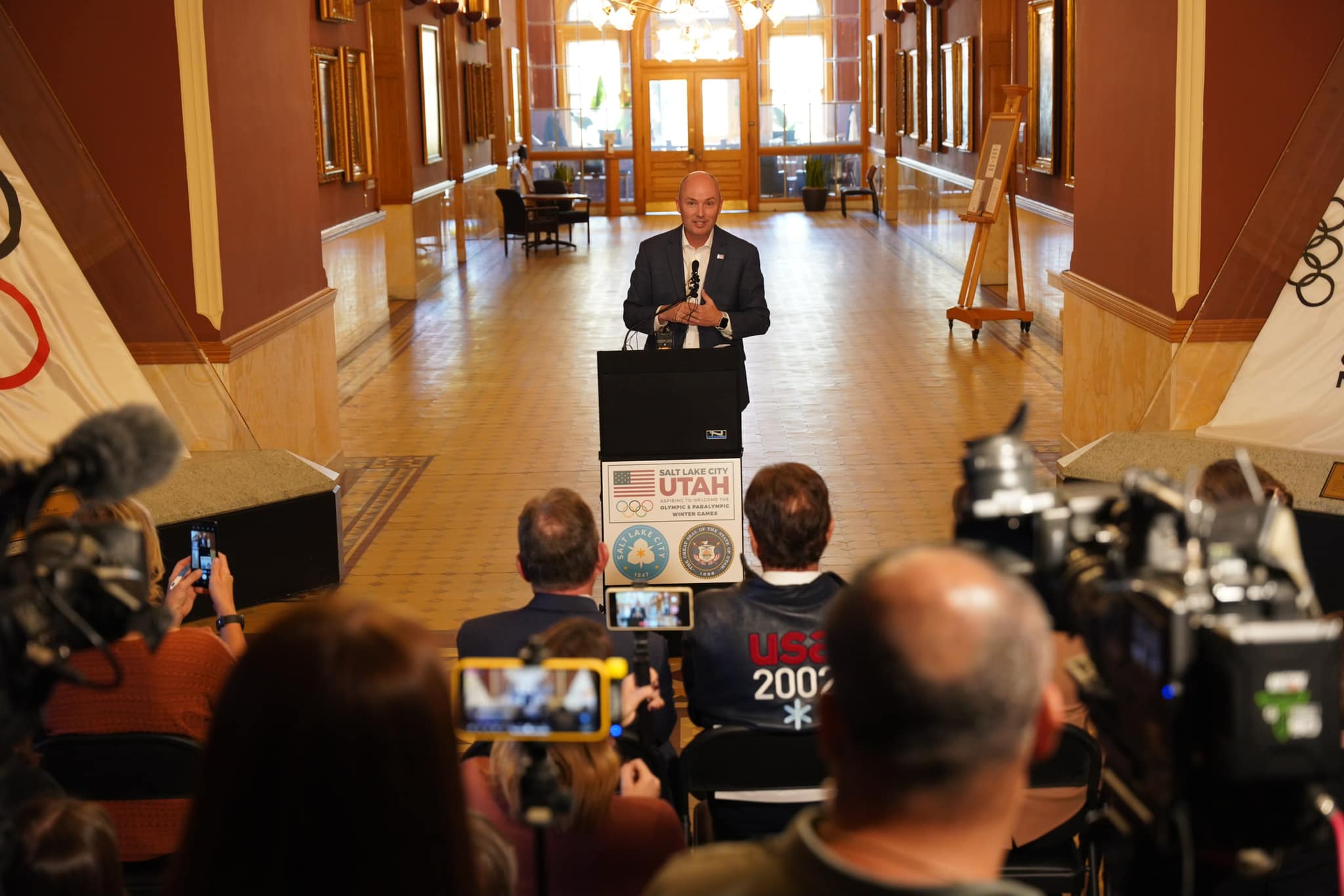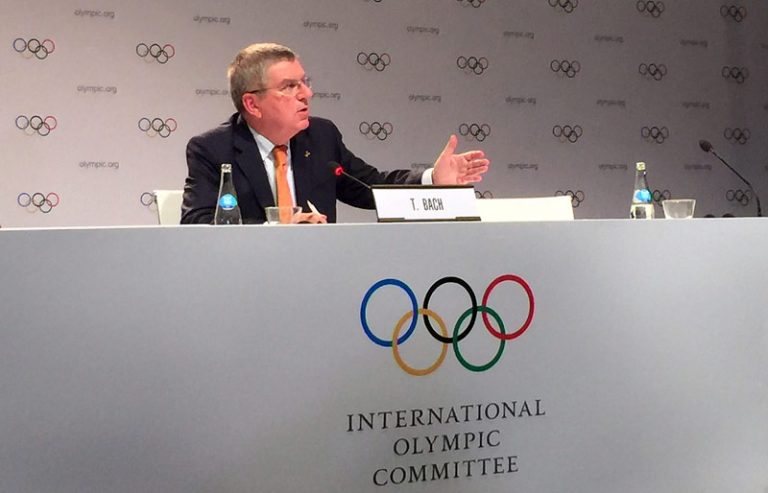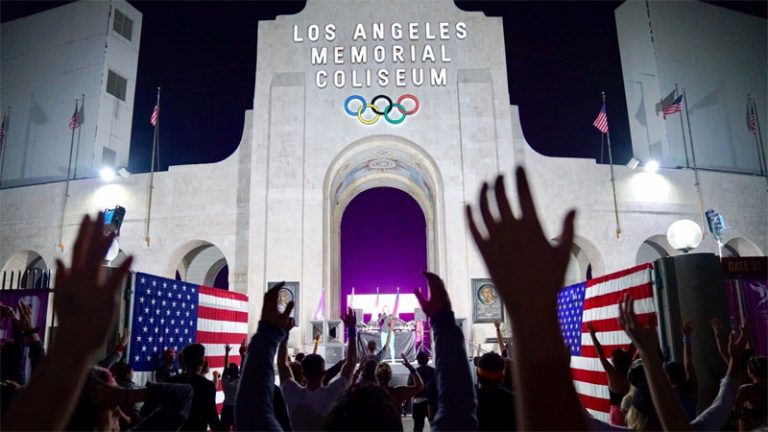“No!” I shouted in my head, slapping my desk as I listened to a Salt Lake City 2034 Winter Olympics bid press conference on a Facebook livestream last month.

“Just no,” I thought, more resigned.
“Don’t even think it,” I then whispered.
Salt Lake City is offering the International Olympic Committee (IOC) one of the most promising Olympic bids ever imagined. The project is so completely aligned with everything both the IOC and the Utah capital want that last month the IOC declared that it will elect both 2030 and 2034 Winter Games hosts at the same time next year – a mechanism designed specifically to elect Salt Lake City, the only bid in the running for the latter edition.
Bid and government leaders recognized the reality of the IOC’s decision but stayed remarkably humble during the press conference even as in their minds they were taking victory laps.
“There is no reason to do what they just did if they’re not interested in Utah getting the 2034 Games,” Utah Governor Spencer Cox said.
Then he pushed it too far.
“This will give us a horizon of sorts that will allow us – we’ve been so focused on working to get the Games, making sure again all of the infrastructure in place the bid is ready to get the Games – but getting that award will allow us again to start to dream big on what we want to do,” Cox added.
Then Salt Lake City Mayor Erin Mendenhall, who is up for reelection this month, jumped in.
“I am hopeful that if we are awarded the Games our applications to access those federal tax dollars to do these kind of projects will receive great favorability because of our opportunity to host the world,” she said.
There it is. That’s when I reacted. The loose rail that could disrupt the organization of an otherwise idyllic bid that has been designed to run like a bullet train. Instead, something like an afterthought light rail add-on project could ruin everything.
Sadly, the outcome is inevitable.
Fraser Bullock, CEO of the Salt Lake City-Utah Committee for the Games (SLC-UT) stood by stoically at the press conference as the politicians dreamed more about what the Olympics could help them accomplish than the Games themselves. Bullock, also COO of the Salt Lake City 2002 Games knows the space very well. Though transit upgrades, brand new venues and compelling legacies were the formulas for successfully hosting the Games when Bullock was guardian of the flame in 2002 – things couldn’t be more different now – and he knows it.
That’s why when I reached out while preparing this column, Bullock offered no comment on the Governor’s remarks.
It was the construction of many winter sports venues around Salt Lake City, including rare facilities such as a sliding track, speed skating oval and Nordic centre – as well as light rail mass transit – that made the 2002 Games successful for Utah. That same construction, along with years of meticulous upkeep, has put the city in prime position to host in 2030, 2034 and as long as the climate keeps bringing snow to the region.
There are few, if any, cities in the world that could make this same claim.
Not having to build anything yet maintaining an extremely compact Games footprint is what makes Salt Lake City’s bid so compelling and so perfect. Eighty percent public support doesn’t hurt either.
Is it wrong to use a planned Olympics as a catalyst for other locally needed projects? No. But yes. It’s complicated.
“We’re going to build it anyways.”
That had been the mantra shared among Olympic bids over the past decades until constant cost overruns, white elephants and taxpayer bailouts eventually had cities refusing to bid altogether. As many as nine, 10 or 11 cities used to line up, promising to build monuments to the Olympic Movement. Stadiums, highways, rail lines and Olympic villages turned into housing – all in the name of an Olympic Games – became legacies of seven magical years of preparation.
Then there was the art of bid committees trying to convince taxpayers that these projects were valuable and an Olympics would be the best way to get them delivered.
Not anymore.
Last year the International Olympic Committee (IOC) had to pause the 2030 Winter Games bid race when there were no cities – zero – focused on hosting that edition. Most early interest in pursuing a Games typically ends when someone references USD $51 billion spent to stage the Sochi 2014 Winter Games, whether a fair comparison or not.
Now the IOC is practically begging potential hosts to build nothing and instead use venues where they already exist even if across international borders. The entire process has been changed so that the IOC’s Future Host Commissions can help bidders formulate plans in private and encourage efficient and low cost Games.
But let’s be clear, the Sochi 2014 Winter Games did not cost $51 billion. It was a stadium, arenas, chair lifts, sliding track, highways, railways, housing, hotels, a theme park, inefficiencies (read corruption) and so much more that cost $51 billion. To organize the Games themselves: maybe $2 billion.
Maybe Russia wanted all of those things. Maybe they “were going to build it anyways.”
It didn’t matter. Perception is everything.
Around the world the price tag for the Games was $51 billion. That was the number that made most nations and taxpayers lose interest in hosting the Games resulting in an existential crisis for the Olympic Movement. In 2015 four European bids dropped out of the race for the 2022 Winter Games leaving only Beijing and Almaty to duel it out. For 2024 only Paris and Los Angeles remained after three cities canceled plans. Choices were so limited that the IOC decided to award both cities the Games – in 2024 and 2028 respectively.
It wasn’t just Sochi. Construction for Athens 2004, Beijing 2008 and Even Tokyo 2020 came in way over budget and had underutilized legacies.

In the following years the IOC gradually, then more quickly, adopted a policy to discourage new venue construction eventually pleading that applicants propose use of only existing venues or use temporary facilities. The IOC strongly discouraged PyeongChang from building its sliding track for the 2018 Games suggesting that bobsleigh, luge and skeleton events take place in Nagano, Japan instead. South Korea built it anyways.
Similarly the IOC warned Italy against reconstruction of the Eugenio Monti sliding track in Cortina d’Ampezzo as part of the joint Milan-Cortina 2026 bid in 2019. Initially organizers committed to its construction but recently abandoned plans when costs escalated, and sliding events will now take place elsewhere in Europe. But Italian organizers did find existing venues for many other sports resulting in one of the most spread out concepts ever with events to be held across Northern Italy.
Bids that are now lined up for 2030 after the IOC’s pause have only come to the table because they can use existing facilities. For the first time ever Switzerland has proposed a national bid with events to be held across the country. Sweden’s plans include clusters hundreds of kilometers apart with sliding proposed for Latvia. The French bid will encompass regions across the Alps.
The new bid process is conducted almost entirely in secrecy with interested parties only revealed by the IOC once they have revealed themselves, or, if they are chosen as a preferred candidate with the intention of putting them on the election ballot. Though famously IOC president Thomas Bach suggested the new, opaque bid process was to avoid “too many losers,” the inferred intention here is to control the public dialogue and help shape the plans so the bids look the way the IOC wants them.
IOC Executives know that perception is everything. They know the future viability of the Olympic Games relies on regions willing and able to host. And in this world of social media and fake news, they know it is important to prepare and strategically send a conversation-starting message before others do it for them.
That’s why – and I can’t stress this enough – suggestions by Utah’s governor and Salt Lake City’s mayor that there could be add-on infrastructure projects dependent on taxpayer funding and constricted by a boxed-in timeline will not sit well with the IOC or SLC-UT.
“Think back to 2002 some of the changes that were made. Transportation I think is a big one, right? There was a big push to do some major transportation projects that needed to be done,” Governor Cox said.
At the time, Salt Lake City was in a heated race among nine initial candidates. Remember, the one that was later marred by the bribery scandal where ten members of the IOC were expelled and another ten were sanctioned for taking gifts or cash in exchange for favorable treatment on election day? The IOC itself was in a powerful position to demand transport upgrades and brand new venues as cities were clamoring to host.
As they say, it was a different time.
Thinking about connecting similar projects to a bid now is dangerous – mostly for the IOC.
“It also gives us a marker,” Cox said, adding, “and I think having goals and markers are really important, especially in government where far to often, not here in Utah but generally, people just look to the next election.”
Those “markers” that Cox refers to, the hard scheduled dates for the opening and closing ceremonies of the Games, are the biggest threat to large infrastructure projects. With fixed time constraints, projects become vulnerable to any outside changes such as material shortages, labor strikes, inclement weather, public protests, legal issues, etc., etc.
Typically projects with these kinds of issues just get delayed – everyone who lives in any city anywhere knows this. But with the Olympics that can’t happen. The solution? Pour more money into it. That’s why an overwhelming majority of Olympic infrastructure projects go over budget. It’s inevitable.
Those costs, even though “we’re going to build it anyways” get tacked on to the perceived price of the Olympics. Once the project is mentioned in the same breath as the Olympics – it’s connected.
The IOC wants no connection to these projects. If Utah wants to build a light rail expansion or airport highway improvements – great. But the IOC prefers that the topic is not raised in a press conference about the Olympics.
It’s not difficult to see how the IOC’s expectations around infrastructure have changed over the years. Just take a look at the candidature files – known as bid books.
The Salt Lake City 2002 bid listed in its so-called “non OCOG” budget (capital investment beyond the actual organization of the Games) airport improvements, road upgrades, hotel construction and several new competition and accommodation venues. These are included because the IOC requested the information as part of the bid dossier.
For the Vancouver 2010 Winter Games the non OCOG budget included mostly competition venues and athlete accommodations. Absent was the cost of the CAD $600 million (USD $433 million) Sea-to-Sky highway improvements – a crucial link between Vancouver and the snow and sliding venues in Whistler that has since become a valuable legacy for British Columbia. Still, on the public record this cost is typically included in the overall Games outlay.
For Sochi’s $51 billion 2014 edition there are non-descriptive single line items for “Airports”, “roads and railways”, “visitor accommodation”, “Olympic Villages”, and more – including the many competition venues (but no mention of the theme park!). The bid book total of operating and capital costs was just above USD $10 billion.
Pyeongchang’s breakdown for 2018 closely follows Sochi’s, but remember – that bid book was written in 2011, well in advance of the Sochi’s Games.
Then in 2015, Beijing produced its bid book for the 2022 Winter Games. Detailed costs were provided for competition and non-competition venues, but missing were extraneous infrastructure costs like airports, roads and railways. This was not a trivial omission because one of Beijing’s most important deliverables in its concept was also likely its most costly – the high speed rail link to Zhangjiakou where many snow events were staged.
The rail line was to cut travel times from 3 hours down to as low as 45 minutes having a huge impact on the accommodations plan and the viability of the Games.
Ultimately, the cost of the line was reportedly about 58.4 billion yuan (USD $8 billion) – but this was not disclosed in advance.
When I pressed the IOC’s Evaluation Commission Chair, Russian IOC member Alexander Zhukov for details around the potentially risky project – he was quick to distance himself from it.
He told me in Beijing in 2015 during the site inspection “the high speed railway is just a part of… a big project not related to the Olympic Games,” indicating that the rail costs were not discussed.
He was angry that I asked, especially as one in a tiny group of international journalists among a large group of Chinese stakeholders in a press conference.
That marked the end of the IOC having anything to do with major infrastructure projects connected to the Olympics.
In the Milan-Cortina 2026 Winter Games bid book the non-OCOG (capital investment) budget is completely removed, leaving only the operating balance sheet.
Brisbane’s bid to host the 2032 Summer Games also omitted construction costs even as the rebuilding of the historic Gabba cricket grounds, promised as part of the Games pitch, is estimated to cost as much as AUD $2.7 billion (USD $1.72 billion). In the media, it is widely included in the cost of the Games.
So are the costs of regional rail upgrades deemed necessary for those Games that will amount to an estimated AUD $1.12 billion (USD $712 million). An additional six new venues have been proposed, without specifying costs, but the IOC has encouraged officials to use existing facilities instead.
Brisbane’s bid book projected the operational costs of the Games would amount to almost AUD $5 billion (USD $3.2 billion) but although Australia’s Summer Games are still almost nine years away, critics are already identifying major cost overruns and public opposition is mounting.
Salt Lake City’s “no build” Games are expected to cost about USD $2.2 billion that will be privately funded by the IOC, sponsors and ticket and merchandise sales. Security costs, as with most Games, will be covered by public agencies.
But if the state of Utah connects – for example – a $500 million transportation project to the Games, the price of the Games appears to increase to $2.7 billion. If that project goes over budget by 20 percent due to time constraints then suddenly the Games will seem to have cost $2.8 billion. The final cost of Salt Lake City 2034 will have gone 21 percent over budget, reports will say, even if the organization of those Games were right on budget.
My long winded point: don’t do it. Don’t pile on pet projects to an otherwise smooth running Games.
For the sake of the future of the Olympic Movement, keep Salt Lake City 2034 perfect. Don’t squander this opportunity to create a benchmark Olympic and Paralympic Winter Games, one that to all critical eyes remains sustainable and on budget.
I’m not suggesting in any way that IOC Executives will deny Salt Lake City the Games in 2034 if they sense infrastructure projects are on the way. It’s likely already a lock for the Utah capital – expect it to be elevated to targeted dialogue when the Executive Board meets at the end of this month with final member rubber-stamping coming next summer.
I’m also not suggesting that Utah should avoid ambitious construction plans. After all, such projects got the region to where it is today – at least one and probably two Winter Olympics and further dreams of attracting National Hockey League and Major League Baseball franchises in the next decade.
I’m only suggesting this: politicians, please do not link any projects to the Winter Olympics.
Thank you.


